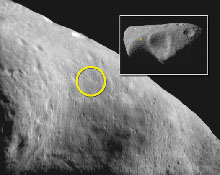Click on image for full size
Courtesy of NASA/JHUAPL (John Hopkins University, Applied Physics Laboratory
NEAR to Touchdown on Surface of Asteroid!
News story originally written on February 2, 2001
The NEAR spacecraft has been in orbit around the asteroid Eros since Valentine's Day of last year. It has met all of its science goals. It has been a huge success within NASA's low-cost planetary exploration program!"With the spacecraft just about out of fuel and our science objectives met, this is a great way to end a successful mission," said NEAR Mission Director Dr. Robert Farquhar of APL. "It's all bonus science. It's never been tried before and it certainly is a complicated set of maneuvers, but at this point the only real risk is not taking one." And just what is that risk? Well, on February 12, 2001, NEAR will attempt to land on Eros! This has never been attempted before!
NEAR will be over 196 million miles from Earth when touchdown occurs. The main goal will be for NEAR to collect close-up pictures of the surface of Eros before touchdown occurs. It could actually take pictures of surface features about 4 inches across. That sure is close-up! Scientists have no idea whether or not NEAR will be functional after attempting this descent, but they hope to at least receive a signal from the spacecraft. "The whole sequence of engine burns has to go right, or it might not be a very soft touchdown," Farquhar said. "The unknown nature of the surface makes it hard to predict what will happen to the spacecraft, especially since it wasn't designed to land. The most we can hope for is a beacon from NEAR Shoemaker that says it's still operating."
NEAR will begin its descent at 10:31 a.m. EST on February 12th. After a series of thruster firings, landing is expected just after 3 p.m. EST. Stay tuned for more news on this exciting mission!















